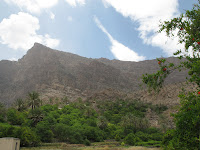 I’m in Oman, plant hunting with a small team from the Royal Botanic Garden, Edinburgh. RBGE has strong links with Oman, Tony Miller has been working in Arabia for getting on for 35 years and he and our team have been asked by the Omani government to explore some of the more isolated mountains, where botanists have not been before. This trip is a recce to see what we can find on some of the less isolated, but still precipitous mountains. The Hajar mountains are a dramatic range parallel to the coast east and west of Muscat. They are intimidatingly dramatic and, without a continuous plant cover, they’re exposed to weather in a big way. Great chunks of rock look like they slid down the mountain yesterday and loose, slippy stuff is everywhere. There are plateaus though, with a cooler and damper climate and villages are scattered across the more accessible places, especially on the Sayq plateau in the Western Hajar.
I’m in Oman, plant hunting with a small team from the Royal Botanic Garden, Edinburgh. RBGE has strong links with Oman, Tony Miller has been working in Arabia for getting on for 35 years and he and our team have been asked by the Omani government to explore some of the more isolated mountains, where botanists have not been before. This trip is a recce to see what we can find on some of the less isolated, but still precipitous mountains. The Hajar mountains are a dramatic range parallel to the coast east and west of Muscat. They are intimidatingly dramatic and, without a continuous plant cover, they’re exposed to weather in a big way. Great chunks of rock look like they slid down the mountain yesterday and loose, slippy stuff is everywhere. There are plateaus though, with a cooler and damper climate and villages are scattered across the more accessible places, especially on the Sayq plateau in the Western Hajar.
We went to visit Wukan, a village perched on a cliff on the north side of Sayq plateau a couple of days ago. It was a long drive through a wadi on gravel roads. We got into Wadi Mistall through a narrow gorge where, like just about everywhere in Oman, there was massive road construction. Once through the gorge the wadi opened out into a huge bowl, circled by the cliffs of Jabal al Akhdar and Jabal Nakhl (one of our mountains, with no apparent way up it). Wukan was right at the head of the bowl up a steep dirt track. It was a small place but busy with children who’d all just come back from school. We climbed up through the terraces, following a falaj that irrigated the fruit trees, pomegranates, almonds, apricots and dates. Higher up there was water in a tank, the first fresh water I'd seen on this very dry trip. I got quite excited about it until we reached the top of the village and looked up to see dark clouds gathering and thunder in the distance. We made a swift descent and got back to the car just as the first drops fell. Rain is a scary prospect on these loose dirt roads and we were glad to get down the steepest slopes before it really started hammering it down. The road turned to a mini wadi and waterfalls ran down the mountains where only an hour before running water was inconceivable. It transformed the landscape, especially the colours that suddenly became rich and clean.
1 comment:
How exciting! I didn't get to the Sayq plateau but I think that was where I hoped to find a continuous falaj to follow.. Have you found any plants?
Post a Comment